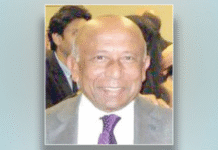Old Dhaka needs a change from within

Mubasshar Hussain, architect and vice president, Bangladesh Poribesh Andolon (BAPA), talks to Naznin Tithi of The Daily Star about the prospects of redevelopment of Old Dhaka and the measures that should be taken for an effective relocation of the chemical warehouses situated there.
Since the deadly Chawkbazar fire, the issue of redevelopment of Old Dhaka has been under discussion. But what does this redevelopment mean? Will Old Dhaka’s distinct character remain intact after its redevelopment?
Old Dhaka can be turned into the most beautiful place in Dhaka if we can properly redevelop it. As part of the redevelopment process, the heritage buildings should be protected and renovated if needed, keeping their original character intact. Recently, Sardarbari, a heritage site in Sonargaon, was renovated by a team led by the past president of the Institute of Architects Bangladesh (IAB). Likewise, the old buildings that have been declared heritage buildings by the High Court should be renovated and protected. To encourage people (owners) to protect the heritage buildings, the government should introduce a law—TDR (Transfer of Development Right), which already exists in many countries. Moreover, the unauthorised buildings should be removed and Bangladesh National Building Code-2008 should be followed in building new structures.
Then comes the issue of improving the road conditions. There is no doubt that widening the narrow roads is very important. But only widening the roads will not solve any problem. There are many wide roads in Dhaka where there is huge traffic jam. It takes 2/3 hours to come to Dhanmondi from Uttara although the roads are quite wide. In many developed countries, there are places with narrow roads like those in Old Dhaka but that never becomes a problem because of the way they manage them. With proper management, the conditions of the roads in Old Dhaka can be improved significantly. The narrow roads can be made one-way. Or we can enforce some restrictions on movement of vehicles on them. The roads that are too narrow can be made off limits to cars and other modes of transport by building gates at both ends of the roads, allowing only rickshaws to move through. The decisions should be taken by the transport experts with consultation with the local residents and the authorities concerned.
Setting up water hydrants in the roads of Old Dhaka is something that we have been demanding for long. Dhaka is the only capital in the world that is surrounded by four rivers. But it is most unfortunate that during fire incidents, the fire brigade often cannot do their work properly because of insufficient water sources. If there were water hydrants, scarcity of water would never be an issue. However, water hydrants will not serve any purpose unless the fire brigade buys special pumps which will be connected to the big vehicles. These pumps can be unlocked from the vehicles and dragged to the site of fire. Such pumps were used in the small towns of the country in the past.
With the money spent on building a flyover, it is possible to set up water hydrants in the entire Old Dhaka area. According to government estimates, the flyovers in Dhaka serve only eight percent of the residents. But still such projects are taken because those involved get commission from these projects.
And finally, the chemical warehouses and factories should be relocated in a separate place with modern facilities. These were some of the suggestions we had made after the Nimtoli tragedy. But, as it seems, all the efforts made at that time miserably failed to bring any result because none of the decisions taken were implemented.
Do you think the way the government has been progressing with their relocation plan and conducting drives against chemical warehouses and factories will be sustainable? How about engaging the local residents with the whole process?
The decision of relocating the chemical and plastic warehouses and factories in a separate area must be implemented to save Old Dhaka from recurring fire incidents. But forcing the owners to do so, disconnecting the utility lines, and fining the owners of warehouses may not help. If the traders are forced to stop their business here, new chemical factories will spring up at different corners of the city and the whole city will be at risk.
So, the government needs to engage the local residents in the whole process. Instead of threatening them with jail terms and giving them 24-48 hours’ prior notice to shift their business, they should be motivated in a way so that they willingly agree to relocate the warehouses in the government-fixed area. This can be done by giving them incentives. The tenants of the warehouses have to pay a lot of money as rent. The government can take decisions such as giving tax waivers, say, for five years, to those who would relocate their factories and warehouses, and impose higher tax (say, 400 percent) on those who want to stay in Old Dhaka. Giving loans at low interest rates may also encourage many to shift their businesses from here. Also, before starting the relocation, the government needs to ensure all structural and other facilities in the designated area.
The present condition of the tanneries that were relocated a few years ago should be a reminder for us as to what happens when relocations are done without properly developing the infrastructure and other facilities. While previously the tanneries at Hazaribagh would pollute only Buriganga, now they have been polluting all the four rivers around Dhaka, because the ETPs (Effluent Treatment Plants) are not working there.
Which government agency should take the leading role in the relocation process—since there seems to be severe mismanagement among the different agencies concerned?
The mismanagement and lack of coordination among the various ministries and agencies concerned were revealed during and after the devastating Chawkbazar fire. At a time when all of them should have worked together under the leadership of the mayor, they were blaming each other for the incident.
Let me cite some examples of mismanagement. While it is under the mayor’s jurisdiction to change the lights of the city streets, they do not have the authority to repair or remove the electric poles in case these get damaged. Our city corporations have set up one of the best traffic systems here which do not work because the traffic police have been violating the rules. The traffic police direct the pedestrians to cross the roads when the red lights are on and the vehicles move when the green lights are on. This has happened maybe because the city corporations single-handedly took the decision of importing the system. So now every day I learn to violate traffic rules from in front of the PM’s secretariat.
After the Rana Plaza disaster, the home ministry bought some fire-fighting equipment which included foam tenders (used to douse fire originated from chemicals) and turntable ladders. But during the recent fire, the foam tenders failed to enter the area. Did the home ministry discuss with the Fire Service and Civil Defence Department before procuring the equipment? Probably not. The fire service department should be brought under the Ministry of Disaster Management and Relief. It would empower the fire brigade to do their job efficiently.
In order to end the unbelievable mismanagement and lack of coordination among the agencies, there is no alternative to forming a city government and empowering the mayors. As per the directive of the prime minister, the south city corporation’s mayor is now trying to relocate the chemical warehouses and factories. If the prime minister has to intervene in every work, I do not understand how this state will run. If all the agencies work under the mayors, we can hold them accountable for any mismanagement or failures. Lastly, architects, engineers, and planners can come up with excellent designs and proposals for making this city liveable, but the responsibility of implementation lies with the politicians.
Source: The Daily Star.









